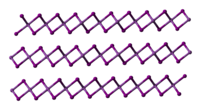Bismuth(III) iodide
 |
|
 |
|
 |
|
| Names | |
|---|---|
|
IUPAC name
Bismuth(III) iodide
|
|
| Other names
Bismuth iodide, bismuth triiodide
|
|
| Identifiers | |
|
3D model (Jmol)
|
|
| ChemSpider | |
| ECHA InfoCard | 100.029.207 |
|
PubChem CID
|
|
|
|
|
|
| Properties | |
| BiI3 | |
| Molar mass | 589.69 g/mol |
| Appearance | greenish-black crystals |
| Density | 5.778 g/cm3 |
| Melting point | 408.6 °C (767.5 °F; 681.8 K) |
| Boiling point | 542 °C (1,008 °F; 815 K) |
| 0.7761 mg/100 mL (20 °C) | |
| Solubility | 50 g/100 mL ethanol 50 g/100 mL 2M hydrochloric acid |
| -200.5·10−6 cm3/mol | |
| Structure | |
| Trigonal, hR24 | |
| R-3, No. 148 | |
| Hazards | |
|
EU classification (DSD) (outdated)
|
Corrosive (C) |
| R-phrases (outdated) | R34 |
| S-phrases (outdated) | S26, S27, S36/37/39, S45 |
| NFPA 704 | |
| Related compounds | |
|
Other anions
|
Bismuth(III) fluoride Bismuth(III) chloride Bismuth(III) bromide |
|
Other cations
|
Nitrogen triiodide Phosphorus triiodide Antimony triiodide |
|
Except where otherwise noted, data are given for materials in their standard state (at 25 °C [77 °F], 100 kPa).
|
|
| Infobox references | |
Bismuth(III) iodide is the inorganic compound with the formula BiI3. This gray-black solid is the product of the reaction of bismuth and iodine, which once was of interest in qualitative inorganic analysis.
Bismuth(III) iodide adopts a distinctive crystal structure, with iodide centres occupying a hexagonally closest-packed lattice, and bismuth centres occupying either none or two-thirds of the octahedral holes (alternating by layer), therefore it is said to occupy one third of the total octahedral holes.
Bismuth(III) iodide forms upon heating an intimate mixture of iodine and bismuth powder:
BiI3 can also be made by the reaction of bismuth oxide with aqueous hydroiodic acid:
Since bismuth(III) iodide is insoluble in water, an aqueous solution can be tested for the presence of Bi3+ ions by adding a source of iodide such as potassium iodide. A black precipitate of bismuth(III) iodide indicates a positive test.
Bismuth(III) iodide forms iodobismuth(III) anions when heated with halide donors:
...
Wikipedia

